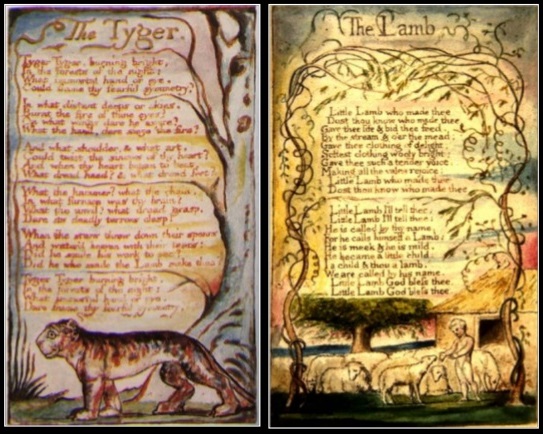The two poems written by William Blake feature animals that are antithetical, one symbolizing the goodness, peace, harmony and unity in the world whilst the other the presence of darkness in the world.
Blake makes a similarity between a lamb and a child which are both gentle, mild, and crooning, giving us the sense of its softness and child-like nature.
He continues the theme of perfect creation by using dark, powerful imagery bringing in the similarity between a tiger and a child growing older, represents the force of death or as an ‘anti- lamb’ expression.
The first word “little lamb” helps to create the mood of the poem with ideas such as “softest clothing woolly bright”, “tender voice” showing its purity. Also, the description of it being “meek and mild” and ” he became a little child” symbolizes Christ, god’s son and innocence.
Framing the tiger’s whole being is “fearful symmetry” and “burning bright”, while “fire of thine eyes” asserting its fierceness and elegance. The “dread hand”, “dread feet” and “deadly terrors clasp” also symbolizes experience and God its creator.
Both poems explore how the presence of innocence, goodness, and unity can be challenged by the presence of experience which is the destruction of the powers of evil.
In both these poems, there are questions being asked about its creator. In “The Lamb” there are more questions that are asked showing the innocence of the narrative. Whereas in “The Tyger” not many questions are asked as the narrative voice is more experienced and is also teaching the lamb.
A lamb is similar to the child and hence in the first stanza of the poem the narrative voice asks questions such as “Little Lamb who made thee”, “thou know who made thee” and is trying to learn the new things which were not known before, this is answered in the second stanza as “Called by thy name”, “calls himself a Lamb” and “God bless thee”.
While the narrative voice in the other poem knows much better and asks how can someone so calm and tender make such an immortal and ferocious animal as well and is that person happy or sad, “What immortal hand or eye/Could frame thy fearful symmetry” and “Did he smile his work to see/water’d heave with their tears”.
This tells us that a child when born is innocent and tries to learn and new things which they have never seen and known before but also have new experiences when growing up.
Both the poems follow the simple AABB rhyme scheme and devices such as repetition and alliteration. It shows the simplicity and honesty of a lamb as well as the death and immortality of a tiger.
In “The Lamb” the rhyme scheme is “thee”, “feed” and “mead”, “mild” and “child”, keeping the rhymes simple Blake conveys the tone of childlike wonder and the singsong voice of innocent boys and girls. The soft vowel sounds and repetition of the “l” sound may also convey the soft bleating of a lamb. The repetition and alliteration “Little Lamb” also brings out innocence and tenderness.
“The Tyger” follows the same rhyme scheme throughout; “heart” and “beat”, “bright” and “night” but the somewhat problematic rhyming of “eye” with “symmetry” draws attention to the tiger’s ferocity. Repetition and alliteration “Tyger Tyger, burning bright” again emphasizes its fierce and evilness. Through repetition, alliteration, and the same rhyme scheme is used it is represented in two different ways. One giving us a discomfort feeling.
There is a nice rhythm and tone in both the poems, one which is soft and child-like and the other which is a bit fearful. Blake uses powerful and intimidating imagery to create an awed tone in “The Tyger”.
Whereas the tone of “The Lamb” is gentle, soft and adorable, illuminating the innocence of the lamb. The energetic and mighty tone is expressed by “hammer what the chain?”, “furnace was thy brain?” and “the hand, dare seize the fire?” while a soft, soothing and calm tone is expressed by “meek and mild” or “tender voice”.
Hence after reading the poem we understand that we have to have both the characteristics of a tiger as well as a lamb and also understand how the two poems are companion poems explaining the evilness and goodness of humankind.

